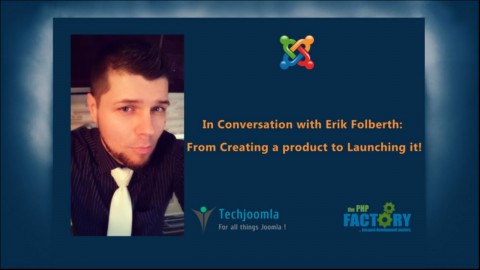The Techjoomla Blog
In Conversation with Erik Folberth: From Creating a product to Launching it!
Have you ever wondered what are the best practices in planning a new concept or idea and what goes into the process of turning ideas to realities?
We ourselves do a lot of Product Development here at Techjoomla as well as at our parent company. We have closely seen the process of product development from ideation to production and marketing it. So it was very interesting to get another perspective at this when we interviewed Erik Folberth from thePHPfactory (one of our partners). Let's see what he has to say!
What is your first thought on creating a new product?
It's always a good idea to analyze the mistakes from the past when working towards the creation of a new product, or of a new website.
We all know it has to be complex, but in the same time not to overlook its simple structure, which helps the page visitor to find the needed information as quickly as possible. Structure and overview are the keywords here.
From your experience what have been the most common flaws in your customer's plans to launch a new platform?
Wanting a complex website is good, but a common mistake is allowing different workflows on the same site. Focus on your target audience and offer them something particular and very specific. For example it's alright to create a dedicated auction website, with search customizations, custom fields, specific user profile pages, multiple payment methods for highlighting special auctions, etc. but it becomes confusing when the same website offers also for example a classified ads system, since the workflow is different and the common pattern is that each website has a particular workflow, not several ones. By working with already established patterns, it allows a faster thinking process of the visitors, so that they can concentrate on the needed actions to be taken on the page, not losing time just to search for them or understand them.
My advice here to any webmaster, is to build separate websites for each particular workflow (only if a bigger platform is involved, then perhaps to create a unified logging system, like Google is offering for its products) and to really see through each dedicated website, by planning it in detail and properly developing each feature, in order to offer that unique flavor, thus creating a very attractive solution.
What is there to consider, after a target and workflow have been set?
Concentrate first on the website features and only after finalizing them, apply a certain template. Even if as a webmaster, you acquired a very good, reliable extension, invest the time in refining all the details on your site. Like matching the template elements, create a unique look and feel of that page, make it particular, but at the same time, as simple as possible and intuitive for its visitors.
Even details which might seem insignificant, could play an important role for your website, which is why it's essential to test all page elements for their functionality, and even proofread all displayed content.
Apply the code and template changes in separate files, so it will make your life easier when the time for updates will come. Sooner or later, if you want to maintain the website further, updates are mandatory.
“Never forget - details are everything!”
What about the maintenance part of any applied solution?
Start small and think about extending the website in the future. For example it makes no sense to launch a multilanguage site (unless you are in Switzerland or Canada:)), since the maintenance workflow will be too high at the beginning (each new content will be added several times for each language) and this time should be invested in marketing, not maintenance.
Do not forget about the first rule in IT! Always backup your website and verify the integrity of the backup files, because it's easier to restore, rather than recreate. Always test any minor changes on a separate site and only after testing, integrate the changes on the live site. Perform a clean install on the live site, without any leftovers from previous installations and keep it simple only with the necessary components.
For security reasons, try to update each extension of your website each time a new release is available; it might also bring several code improvements, making your website faster and more reliable.
But in the end, how can we bring the solution to the public?
When the site is ready and launched, don't let it die. Invest in making it popular, in ads and in attracting people to discover its features. Do that constantly, not only once. To create a certain sustainability, marketing campaigns are a permanent necessity. Keep in mind not to neglect the social media channels either, and target a specific audience, to obtain a higher conversion rate.
Personally, I believe in the quality of your website's content, because no matter how much the platforms will change over the years, the quality and relevance of the content will always be the number one resource to keep your customers close.
Thank you for your time, Erik! I hope all the readers and people who are looking forward to engaging in a new product or any Ideas, have learnt key things on starting a new product to launching it and marketing it as well.
When you subscribe to the blog, we will send you an e-mail when there are new updates on the site so you wouldn't miss them.

